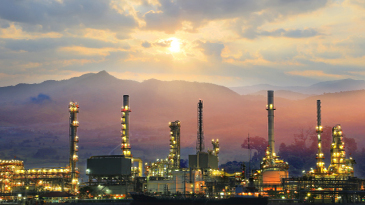As energy companies look to remain competitive in today’s market – with factors like volatile pricing, increasing global competition, aging infrastructure, and a retiring talent pool – digital transformation has become a necessity. Operational excellence is a key performance driver at all energy companies wherein digital transformation, with intense analytical capabilities, has become a necessity for achieving superior results.
Many facets of company performance weigh in on operational excellence, but the key contributor is overall equipment effectiveness (OEE) – how well is the plant running in terms of uptime, energy usage, and quality and quantity of production? The most important metric is always uptime, since it affects energy and product output. Artificial intelligence techniques, such machine learning, are improving uptime and hence operational efficiency at some of the largest oil and energy companies worldwide.
Reliability, uptime, and availability are often used interchangeably even though they have different meanings. However, maximizing equipment availability (to plan) by ensuring assets do not break down is the standard-bearer for AI and Industrial Internet of Things (IIoT) technologies. With predictive maintenance powered by machine learning – pattern recognition and future pattern predictions – energy companies can avoid unplanned downtime and boost OEE.
Automated machine learning and knowledge capture are becoming key elements in solutions to lessen the blow of the talent drain, replacing lost expertise as workers retire and take years of experience with them. As a result, improvements in equipment availability produce the most prolific improvements in OEE, assuring producers get superior lifetime Return on Capital Expended (RoCE).
Barriers to Adopting Predictive Maintenance Solutions
While the energy industry acknowledges such technologies, I think the ease-of-use, skillset requirements, implementation issues, and scalability of current offerings impedes widespread adoption. Additionally, in the zeal to advance new technologies, many begin implementing the technology and platforms before establishing a grounded sense of the business opportunity and the precise way they will be used to create value. History illustrates similar disappointments where over 50% of data warehouse projects failed for the same reasons. The rational viewpoint is to target very specific problems, for example minimizing breakdowns, and ensure the data and analytics fit.
Improving Energy Operations with AI and Machine Learning
AspenTech works with many large energy companies to improve aspects of operational excellence. These companies are increasingly leveraging our deep expertise in predictive and prescriptive maintenance. Embedded AI/machine learning provides real-time insight into plant assets, helping to determine weeks in advance if certain assets are likely to degrade or fail. Aspen Mtell® software uses Autonomous Agents® which run continuously, distinguishing between normal and abnormal equipment and process behavior by recognizing complex data patterns and uncovering the precise signatures of degradation and failure. Upon detecting unusual behavior or failure patterns, Agents alert operators and even prescribe solutions to avoid the failure or at least mitigate the consequences.
For example, Saras, a European oil refinery, used Aspen Mtell to predict imminent equipment failures 24-45 days in advance. That’s significant lead time, allowing plant staff to avoid unplanned outages or to safely plan repairs. The big value-add of such advanced warnings is that energy companies are no longer victims to production losses, which can lead to millions of dollars of lost revenue and profits. Such time and warnings also help plants run safer and greener.
AspenTech will strategically be folding AI/machine learning into other technologies where energy companies already derive great value. In the future one may expect to see AI augmenting solutions such as refinery and petrochemical planning and scheduling and simulation modeling for design and dynamic optimization. Drawing on the insights these tools can deliver allows energy companies to make better decisions about process design and production schedules to capture greater profits.
Read the full Saras case study.
Many facets of company performance weigh in on operational excellence, but the key contributor is overall equipment effectiveness (OEE) – how well is the plant running in terms of uptime, energy usage, and quality and quantity of production? The most important metric is always uptime, since it affects energy and product output. Artificial intelligence techniques, such machine learning, are improving uptime and hence operational efficiency at some of the largest oil and energy companies worldwide.
Reliability, uptime, and availability are often used interchangeably even though they have different meanings. However, maximizing equipment availability (to plan) by ensuring assets do not break down is the standard-bearer for AI and Industrial Internet of Things (IIoT) technologies. With predictive maintenance powered by machine learning – pattern recognition and future pattern predictions – energy companies can avoid unplanned downtime and boost OEE.
Automated machine learning and knowledge capture are becoming key elements in solutions to lessen the blow of the talent drain, replacing lost expertise as workers retire and take years of experience with them. As a result, improvements in equipment availability produce the most prolific improvements in OEE, assuring producers get superior lifetime Return on Capital Expended (RoCE).
Barriers to Adopting Predictive Maintenance Solutions
While the energy industry acknowledges such technologies, I think the ease-of-use, skillset requirements, implementation issues, and scalability of current offerings impedes widespread adoption. Additionally, in the zeal to advance new technologies, many begin implementing the technology and platforms before establishing a grounded sense of the business opportunity and the precise way they will be used to create value. History illustrates similar disappointments where over 50% of data warehouse projects failed for the same reasons. The rational viewpoint is to target very specific problems, for example minimizing breakdowns, and ensure the data and analytics fit.
Improving Energy Operations with AI and Machine Learning
AspenTech works with many large energy companies to improve aspects of operational excellence. These companies are increasingly leveraging our deep expertise in predictive and prescriptive maintenance. Embedded AI/machine learning provides real-time insight into plant assets, helping to determine weeks in advance if certain assets are likely to degrade or fail. Aspen Mtell® software uses Autonomous Agents® which run continuously, distinguishing between normal and abnormal equipment and process behavior by recognizing complex data patterns and uncovering the precise signatures of degradation and failure. Upon detecting unusual behavior or failure patterns, Agents alert operators and even prescribe solutions to avoid the failure or at least mitigate the consequences.
For example, Saras, a European oil refinery, used Aspen Mtell to predict imminent equipment failures 24-45 days in advance. That’s significant lead time, allowing plant staff to avoid unplanned outages or to safely plan repairs. The big value-add of such advanced warnings is that energy companies are no longer victims to production losses, which can lead to millions of dollars of lost revenue and profits. Such time and warnings also help plants run safer and greener.
AspenTech will strategically be folding AI/machine learning into other technologies where energy companies already derive great value. In the future one may expect to see AI augmenting solutions such as refinery and petrochemical planning and scheduling and simulation modeling for design and dynamic optimization. Drawing on the insights these tools can deliver allows energy companies to make better decisions about process design and production schedules to capture greater profits.
Read the full Saras case study.






Leave A Comment